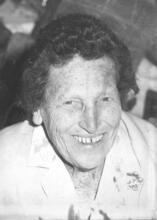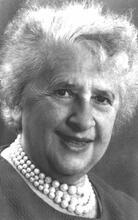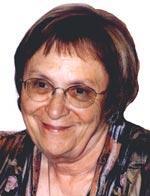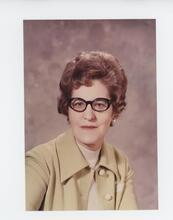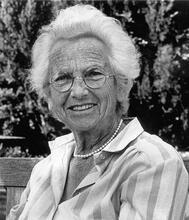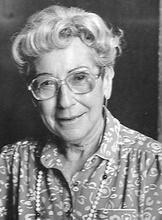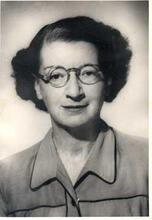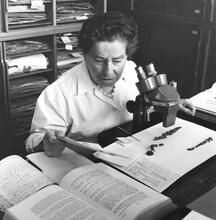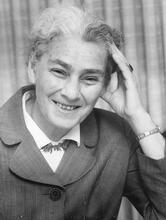Varvara Alexandrovna Brilliant-Lerman
Varvara Brilliant-Lerman was a well-known plant physiologist in Russia, whose main works were devoted to the physiology of photosynthesis. After graduating from the prestigious St. Petersburg Bestuzhev Advanced Courses for Women in 1912, Brilliant received her teacher’s certification and began researching at Petrograd University. Brilliant took advantage of the increased ability of women to have careers in science due to the Bolshevik revolution in 1917, teaching at several institutions in Russia and continuing her well-known study of photosynthesis. Brilliant continued teaching and researching until her death in 1954.
Varvara Brilliant-Lerman was a well-known plant physiologist in Russia. Her main works were devoted to the physiology of photosynthesis. In 1936 the phenomenon of stimulation of photosynthesis by a slight dehydration of plants was named “Brilliant’s phenomenon” in her honor.
Early Life and Education
Varvara Brilliant was born on April 5, 1888, in St. Petersburg into the family of a Jewish lawyer. Like many other Jewish girls Brilliant enjoyed the advantages of a home education based on cultural traditions. At the same time, she acquired a perfect knowledge of the major European languages: German, French, and English.
In tsarist Russia there were severe obstacles to women’s higher education, even in the twentieth century. Jewish girls had the additional obstacle of the three percent education quota (numerus clausus) system and the various measures confining them to the Pale of Settlement (which did not affect Brilliant, who lived outside the Pale). In spite of formidable difficulties Varvara entered the St. Petersburg Bestuzhev Advanced Courses for Women (Vyschie Zhenskie Kursy)—a prime objective of hundreds of young women from all over the Russian Empire, due to the high standards of education and the superior caliber of its professors, who were drawn mostly from St. Petersburg University.
Upon completing her studies in 1912, Brilliant, together with other outstanding students, remained at the Courses to perfect her knowledge in plant physiology. In 1915 she passed state examinations that licensed her to teach at the Women’s Advanced Courses and some private institutes. In 1918 she passed the examinations at Petrograd University and received a master’s degree in biology. Up to 1919, when the Bestuzhev Courses were united with the Petrograd University, she worked at the Courses under the supervision of S. P. Kostychev, head of the department of plant physiology at the Petrograd University and professor of plant physiology at the Bestuzhev Courses.
Career
The Bolshevik Fevolution of 1917 opened up great opportunities for women’s professional careers in science. In 1920 Varvara received a permanent position at the Botanical Institute of the Academy of Sciences. Concurrently she was employed as lecturer at the Polytechnic Institute (formerly the Women’s Polytechnic Institute) (1913–1922), at the State Institute of Medical Knowledge (formerly the Psychoneurological Institute) (1915–1921), at the P. F. Lesgaft Institute of Physical Training (1919–1922) and at the Geographical Institute (1920–1926).
In 1935, Brilliant was awarded a “candidate of sciences” degree (equivalent to the Ph.D.) for her works in plant physiology. In 1941 she became a Doctor of Sciences (higher academic degree in Soviet Russia) with her study “Photosynthesis as a vital function of plants” (published as a monograph in 1949). By that time, she was a recognized specialist in photosynthesis in Soviet Russia and became one of the leading scientists at the Botanical Institute, heading its division of ecology and physiology of plants (1945–1954) and training a number of students and disciples. All of them received doctoral degrees and worked on plant physiology, botany and plant ecology. Varvara Brilliant-Lerman died on May 17, 1954, in Leningrad.
Legacy
Varvara Brilliant’s research included biochemical studies of plant respiration and fermentation, studies of the influence on photosynthesis of ecological factors such as acidity, concentration of potassium, calcium and magnesium ions in soil, concentration of oxygen in the air, etc., revelation of the optimal conditions of photosynthesis, and so on. She proved that photosynthesis is not an ordinary physical-chemical process but is the genuine function of the living plant. Her whole work had a single-minded concern with study of the nature and characteristics of the process of photosynthesis in plants—what she called “the physiology of photosynthesis” (or “the ecology of photosynthesis”). Her work contributed to the establishment of a new field of experimental botany in Russia.
Selected Works by Varvara Alexandrovna Brilliant-Lerman
Synthesis of nitrous compounds after autolysis of yeasts (Russian), with S. P. Kostychev. Petrograd: 1916.
Dyeing of plants (Russian), with V. N. Liubimenko. Leningrad: 1924.
Photosynthesis as a process of vital functions of plant (Russian). Moscow/Leningrad: 1949.
V. A. Brilliant-Lerman. Papers. Archive of the Russian Academy of Sciences, St. Petersburg Branch (PFARAN).
Biologists: A Biographical Sourcebook (Russian). Kiev: 1984.
Sapozhnikov, D.N. and Ermolaeva, E.A. “Varvara Aleksandrovna Brilliant-Lerman.” Botanical Journal (Russian) 39 (1954), no. 6:940–943.
Shkol’nik, M. Ia. And Konovalov, I. N. “Varvara Aleksandrovna Brilliant-Lerman.” Proceedings of the Komarov Institute (Russian) ser. 4, 10 (1955): 7–13.
From the pharmaceutical garden to the Botanical Institute: Essays on the history of Botanical Institute. Moscow-Leningrad: 1957.
Russian Jewish Encyclopedia (Russian), edited by Herman Branover. Moscow: 1994.

